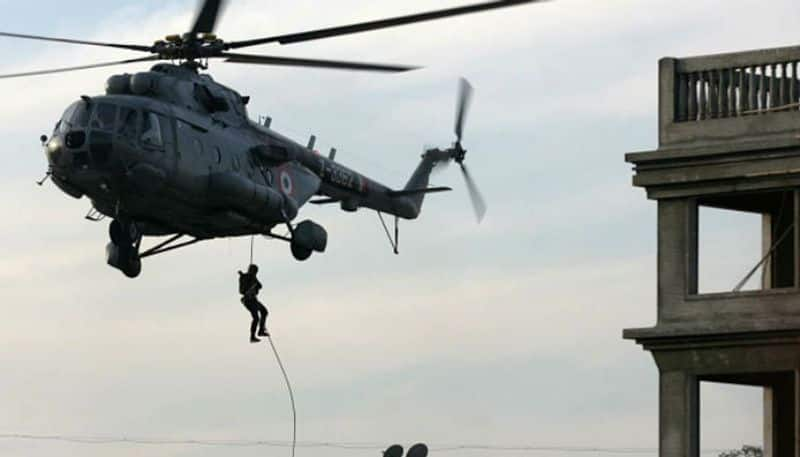To deal with bomb attacks, NSG's bomb disposal units are equipped with robots and a ‘mobile bomb detonation unit’, a containment chamber that can safely carry bombs/IEDs - that cannot be defused on site - to a safer place
New Delhi: Recently deployed in India's most tense state of Jammu and Kashmir, the National Security Guards (NSG) are making artificial intelligence (AI) their primary base for special operations to reduce collateral damage to zero. From unmanned aerial vehicles (UAV) to drones and robots equipped bomb disposal squads, the NSG is adopting technologies that the world's most elite special forces use.
Even during the 2016 Pathankot attack, the NSG successfully completed the operation without any collateral damage and assets of the Indian Air Force were saved. Also, the response time of NSG during the Pathankot attack was lesser than the response time in 26/11.
"The Pathankot operation in 2016 is an example where there was no collateral damage, all civilians, and air assets were safe, all terrorists were killed, and was an example of mature and professional synergy between the state police and the IAF with the NSG," NSG DG Sudeep Lakhtakia told MyNation.
According to Lakhtakia, the NSG used robotics in Pathankot as well. "In Pathankot operation, the NSG scanned the rooms where terrorists were held up with robotic surveillance balls," the DG said. These balls can move anywhere and give a live view of the operational area. It helps the force to locate terrorists easily. In 26/11, the NSG checked locations of the terrorists manually.
Similarly, to deal with bomb attacks, NSG's bomb disposal units are equipped with robots and a ‘mobile bomb detonation unit’— a containment chamber that can safely carry bombs/IEDs - that cannot be defused on site - to a safer place.
When asked about the change since 26/11, Lakhtakia said that the force has changed its technological support completely. "High-end equipment for the commandos like night vision devices, lighter bullet-proof helmets, high-density cameras, lighter armour, world-class tactical boots and the best wheels in the form of combat-ready international class vehicles, anti-ballistic goggles protect the eyes from grenade flashes and splinters from blasts have been bought," he added.
Not only to deal with terrorists on the ground, but to deal with aerial attacks, the NSG is in process of purchasing top end drones and UAVs equipped with weapons. "These drones can neutralize any aerial threat. Such drone can carry electronic intelligence, light weapons and can be operated from kilometres away," a senior official said.
The NSG has also been in touch with young scientists who are looking for new technology as per the force requirement, to deal with any 26/11 or any attacks similar to that of Pathankot.
What has changed in the NSG in the past 10 years?
- Better quality induction of personnel from the Army and police forces – by use of psychological tests, higher educational qualifications, etc.
- Bomb disposal units are equipped with robots and a ‘mobile bomb detonation unit’— a containment chamber that can safely carry bombs/IEDs, which cannot be defused on site - to a safer place.
- The standard operating procedure of handling IEDs has improved significantly to contain the collateral damage and yet be effective in the assigned task.
- Training facility and infrastructure has considerably improved - modern shooting ranges, target systems, mock exercises infrastructure with real-life terror attack simulations.
- Training drills and real life - like joint exercises with other forces and State Police forces - exchanges of best practices.
- Richer content training with foreign forces.
- High-end equipment for the commandos like night vision devices, lighter bullet-proof helmets, high-density cameras, lighter armour, world-class tactical boots and the best wheels in the form of combat-ready international class vehicles, anti-ballistic goggles protect the eyes from grenade flashes and splinters from blasts.
- Modern drones help in assaults.
- NSG canine unit is more versatile – besides support and bomb detection; the dogs are trained to assault terrorists.
(As told by the NSG)
Last Updated Nov 26, 2018, 5:50 PM IST











![Salman Khan sets stage on fire for Anant Ambani, Radhika Merchant pre-wedding festivities [WATCH] ATG](https://static-ai.asianetnews.com/images/01hr1hh8y86gvb4kbqgnyhc0w0/whatsapp-image-2024-03-03-at-12-24-37-pm_100x60xt.jpg)
![Pregnant Deepika Padukone dances with Ranveer Singh at Anant Ambani, Radhika Merchant pre-wedding bash [WATCH] ATG](https://static-ai.asianetnews.com/images/01hr1ffyd3nzqzgm6ba0k87vr8/whatsapp-image-2024-03-03-at-11-45-35-am_100x60xt.jpg)



